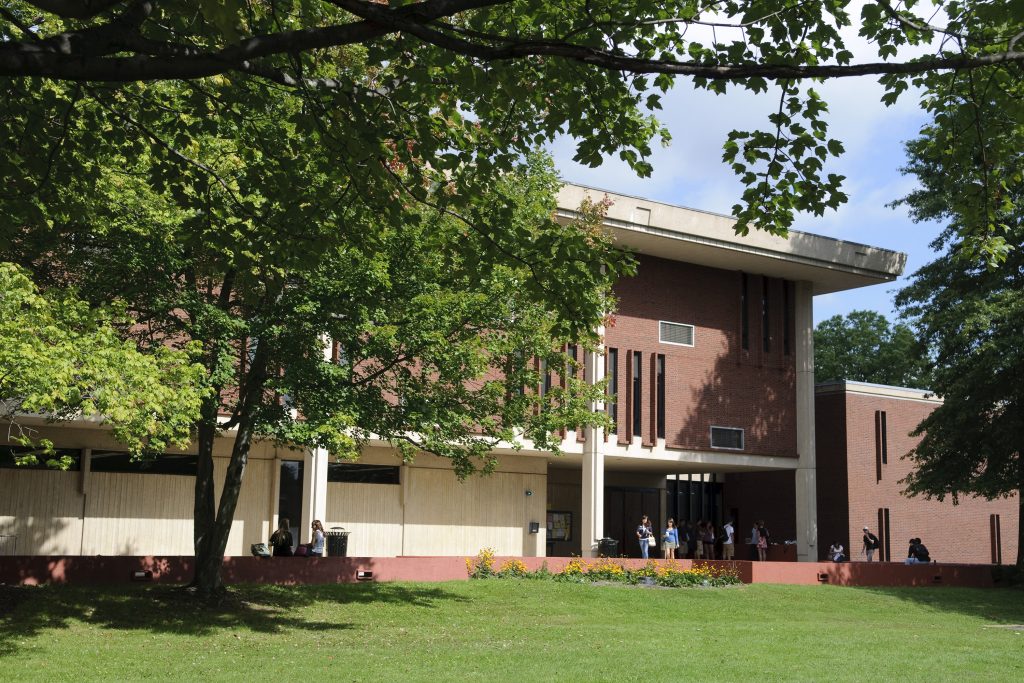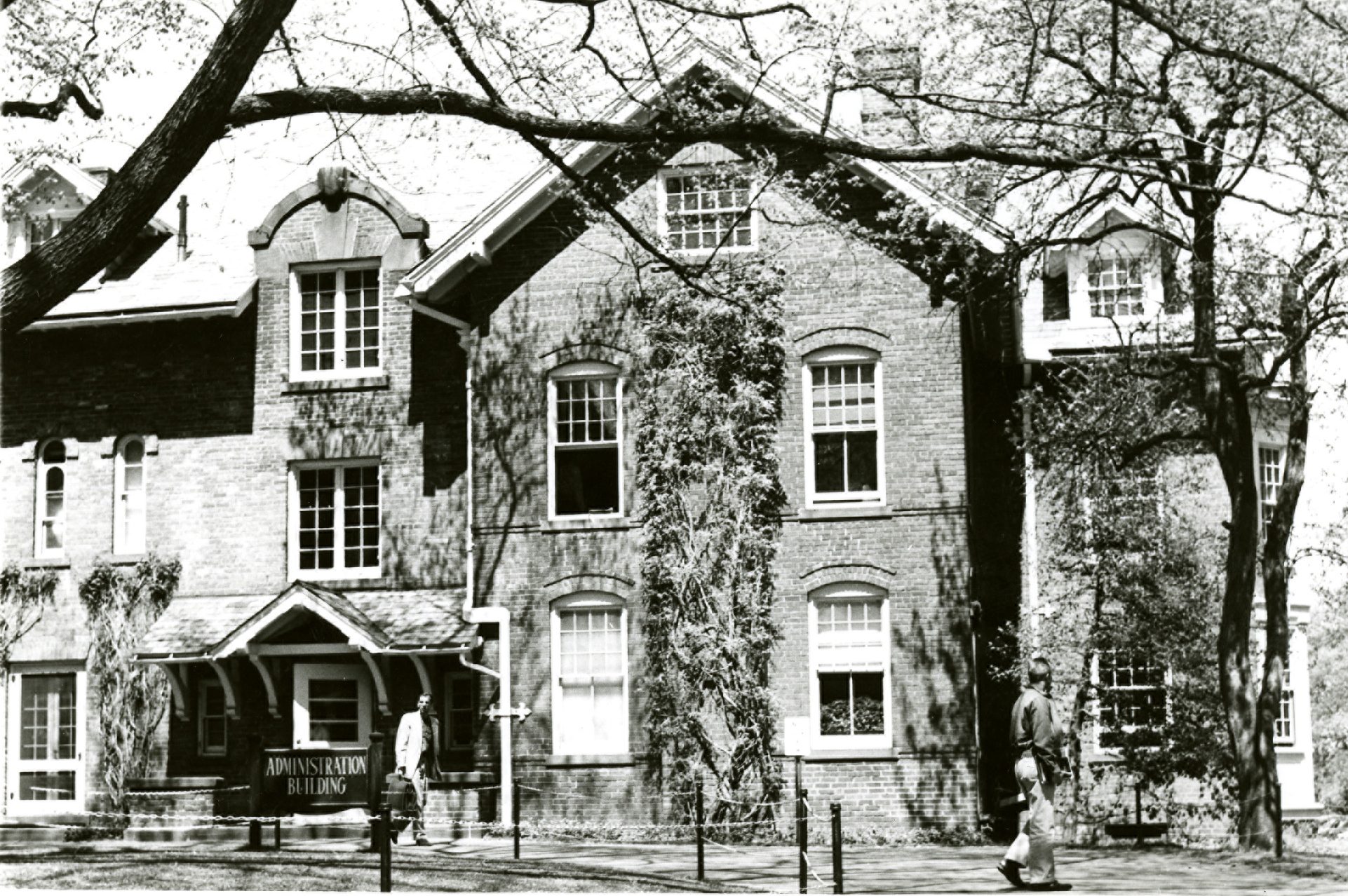When the Hartford Campus opens its doors to students at the new downtown site next fall, it will mark a return to its urban roots. The campus began as an extension center in Hartford in 1939, and occupied five different sites in the city before moving to its current location in West Hartford in 1970.
Soldiers and sailors returning from World War II looking to restart their lives found a new branch of the University of Connecticut in Hartford.
The Hartford branch campus, previously known as the Hartford Extension Center, opened in the spring of 1946 with 30 instructors and an enrollment of 330 students. Courses from business administration to zoology were offered on a schedule that ran from 3 p.m. to 9:35 .m.
Its real beginning, however, was in 1939.

Less than a year after Connecticut State College became the University of Connecticut, a University Extension Center opened in Hartford, offering college-level courses at a location on Bellevue Street. Over the course of its history, the Hartford campus would be housed at a total of six different locations, including the current West Hartford site.
In 1943, the extension center moved to Woodland Street.
Then in 1946, with the influx of war veterans, it became a branch campus and began offering classes at the Henry Barnard Junior High School on North Main Street. At that time it offered courses for freshmen and sophomores, leading to their transfer as juniors to Storrs.
The purpose of the branch campuses at that time was to provide a basic two-year curriculum for students who would move on to advanced work at Storrs or another institution.
Although then-President Jorgensen recognized the emergency needs raised by the returning veterans, he saw the branch campuses as a temporary measure and wanted to centralize as much of the university as possible at Storrs. He thought some of the professional schools should be located in Hartford, but said that once the veterans had been cared for, “The University branches at Fort Trumbull, Hartford, and Waterbury should be withdrawn and absorbed in the University at Storrs.”
This did not happen, however, and in 1951, the campus left Barnard Junior High, working out an agreement with the City of Hartford to use nine rooms in the Hartford Public High School on Broad Street. Enrollment was 778 that year.
Still growing in the post-war years, by 1953 the campus had more than 1,200 full and part-time students. Excluding salaries, the budget for the campus in 1952-53 was $2,600.

The campus’s next move was in 1954, to the Goodwin Estate at 1280 Asylum Ave. in Hartford. The three-story, 22-room mansion, originally built as a girls’ school, had a wing with about a dozen bedrooms. These became the faculty offices. It included a brick ice house, a stable (which became the site of the library’s new quarters), and a garage. Some classes were taught in the former ballroom.
Enrollment continued to increase into the 1960s, and the hopes of students, faculty, and staff rose and fell with a proposal for a new campus in West Hartford. Trustees approved the move on Oct. 10, 1962, but there were significant delays in design and construction, and it was not until Sept. 7, 1970 that the campus moved from its Hartford location at 1280 Asylum Ave. to a new location in West Hartford at 1800 Asylum Ave. Classes began in the new Undergraduate Building one week later.
When Lewis Rome was appointed by Gov. Lowell Weicker as chairman of the Board of Trustees in 1992, he advocated, among other things, that the campus should be moved back to downtown Hartford. However, the UConn 2000 infrastructure renewal bill, in which Rome was instrumental, included updates to the West Hartford campus. An article about the 50th anniversary of the Hartford campus in the UConn Advance on March 28, 1997, noted: “Plans to move the campus to downtown Hartford have been nixed, so the campus is looking forward to serving scholars for years to come at its current home.”
At that time, 1997, the campus had an enrollment of about 1,000 undergraduates and housed an MBA program, the International Public Service Institute, the Cooperative Extension System, and a Bachelor of General Studies program. In addition to the two-year academic programs, there was a four-year program in urban studies and a four-year bachelor of general studies degree. The School of Social Work was also located there.

In April of that same year, the Board of Trustees approved a task force report outlining the mission of the regional campuses: “The five campuses – Avery Point, Greater Hartford, Stamford, Torrington, and Waterbury – will become more integrated with the Storrs campus by providing selected four-year degree programs and courses that will enable students to finish their UConn education close to home.”
Plans were developed first to offer four-year degrees in select areas at the Stamford and Avery Point campuses. Then in October 1997, the University proposed to combine Hartford, Waterbury, and Torrington into a Tri-Campus that would also offer four-year degrees.
State higher education leaders agreed upon an expanded array of undergraduate and graduate programs to be offered by UConn’s regional campuses, with a particular focus at each. The Tri-Campus was to specialize in urban and public policy.
In a parallel move, in spring 1998 then-President Philip E. Austin and senior business leaders in the Hartford area agreed to form a partnership with the Hartford business community “to enhance the economic development of the state of Connecticut and to assist in the economic revitalization of the downtown area.”
As part of this, The Travelers Group offered the University use of space at Travelers Education Center to offer credit and non-credit courses in finance, insurance, information technology, healthcare management, and business.
“As the economy picks up in our region, a trained workforce is critical to our ability to grow. This creative arrangement will bring one of our top schools into the heart of the business community, to help sharpen the skills of our labor force,” said then-Mayor of Hartford Mike Peters.
The arrangement would foreshadow not only the opening of UConn’s Financial Accelerator and Graduate Business Learning Center in October 2004, but also some of the thinking behind the Next Generation Connecticut initiative.

Under the leadership of University President Susan Herbst and Gov. Dannel P. Malloy, Next Generation Connecticut is a multi-faceted $1.5 billion initiative to build Connecticut’s economic future and job creation prospects through strategic investments in science, technology, engineering, and math disciplines (STEM) at the University of Connecticut.
Launched in 2013, the initiative includes relocating the Hartford Campus to a downtown site, anchored by the former Hartford Times building and integrated into the neighborhood and the community.
Construction began in 2015, and the move, which will include the School of Social Work and the Department of Public Policy as well as the undergraduate programs, will take place in fall 2017.
Adapted from an article by Mark J. Roy in the UConn Advance newspaper dated Feb. 2, 1998, and other articles in the UConn Advance.



